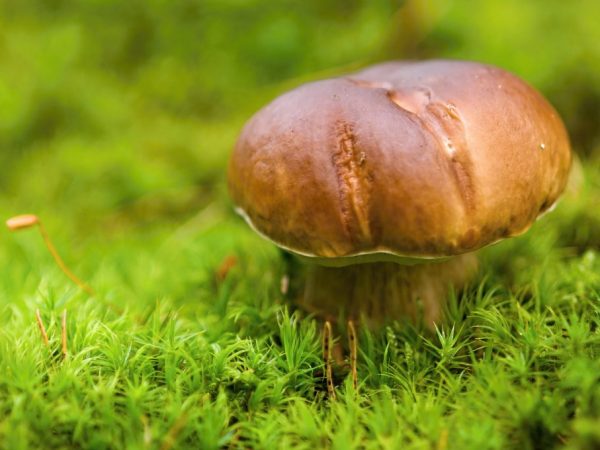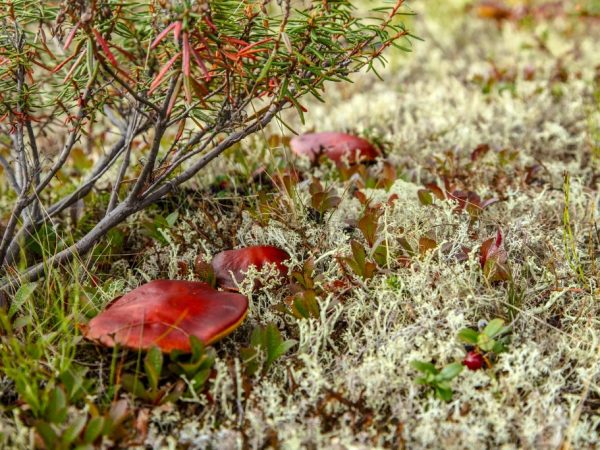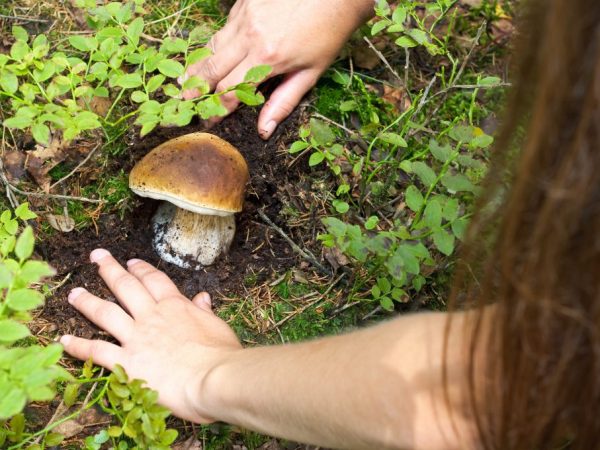What mushrooms grow among mosses
Forests in Russia are all over its territory. In their thickets and in open meadows, berries, medicinal herbs, flowers and a great variety of mushrooms grow, the names of which are simply impossible to list. In shaded places, a mushroom hides among moss, in deciduous or coniferous forests, lovers of "quiet hunting" look for their prey.

What mushrooms grow among mosses
Description
Many types of mushrooms grow in moss: white, boletus, boletus. But the most common is the flywheel. This is where its name comes from.
It belongs to the Boletovye family and looks like a boletus. All types of flywheel have a certain similarity in the description:
- the hat has a velvety outer part;
- cap diameter up to 10 cm;
- the lower spore-forming part is tubular;
- the spores are wide, their color is usually all shades of brown;
- aroma is characteristic, average.
All species growing in moss, except parasitic (false), are edible.
The color of the cap depends on the light level. The vitamin D produced causes a certain coloration on the surface. The hymenophore or hymenium (spore part), depending on the species, has a different color (yellow, red or yellow-green). The color of the spore powder also changes.
Views
In total, there are 18 species of Moss. But the most popular among mushroom pickers are:
- m green;
- m. red;
- m yellow-brown;
- m. Polish;
- m. fractured.
There are several false species (inedible):
- m. bilious;
- m. pepper;
- m. parasitic;
- m chestnut.
Green
This is the most popular and widespread type. In the forest, it is easy to recognize it by its grayish or olive-brown color of the cap. Its shape is similar to a spread pillow of medium size (up to 10 cm), the cap is held on a thickened upward leg, up to 8-10 cm high and up to 1-2 cm in diameter.The flesh is loose, white or light yellow in color, slightly blue on the cut ... The leg has a reddish or greenish brown color, fibrous, with a dark brown mesh.
The fungus is found under deciduous and coniferous trees, in open meadows, near roads and paths. They begin to collect it in late spring, in May and finish in October.
Brown yellow

There are several types of mushrooms in moss.
This species belongs to the genus Butter, although its description does not resemble the usual oiler:
- the color of the cap is brown-yellow;
- the edge is tucked up to the bottom layer;
- surface size up to 14 cm in diameter;
- the pulp turns blue when cut or when pressed;
- cylindrical leg;
- height up to 10 cm.
The synonyms for its name are: "brown-yellow butter dish", motley, swamp.
Irina Selyutina (Biologist):
Butterdish brown-yellow, it is also brown-yellow flywheel belongs to the 3rd category in terms of taste. Young fruiting bodies are best suited for pickling. The skin of the cap in young mushrooms is pubescent, velvety, and in mature ones, it cracks and becomes covered with scales, which disappear in old mushrooms. The flesh is tough, light yellow or lemon yellow in the cap, and brownish in the lower part of the leg. The pine smell is characteristic, but there is no pronounced taste.When processing, it should be borne in mind that the skin separates very poorly from the pulp of the cap.
The aroma is pleasant, the taste is characteristic, average. The pulp has a firm, uniform consistency, light color at a young age. In old mushrooms, it becomes reddish. The pores of the hymenophore turn slightly blue when pressed. It is found in moss, in conifers, in mixed forests of Russia, from late June to late October. Prefers sandy soils.
Red
In the grass or in mosses, there is a red flywheel, which cannot be overlooked and confused with other species.
The body has a crimson stem, on which a beautiful pillow-shaped cap is held, up to 9 cm in diameter. The color of the cap can be either pinkish-purple or cherry-colored or red-brown.
The pulp is homogeneous, dense enough, yellowish, slightly blue on the cut. The lower layer (under the cap - the hymenophore) is yellow and turns blue after pressure on it. Fruiting for about a month: August-September.
Polish
The second name for Polish is brown mushroom. This is due to the brown color of its legs. The yellow tubular surface (hymenophore) is located under the upper part, which reaches a diameter of 20-22 cm. It becomes brown, covered with not beautiful spots, after pressure.
The cap rests on a beautiful dense cylindrical stem of light brown or brown (but lighter than the cap) color. The body reaches a height of 14-18 cm. It has an original pulp, with the aroma of fruits and mushrooms. The pulp is fleshy, with a pleasant smell and sweetish taste, at first it turns slightly blue when cut, then turns brown, and then restores its natural color again. They grow in moss from July to November, in deciduous and mixed forests.
Fissured
This species prefers mixed and deciduous forests (especially if there is linden), sometimes conifers. The mass gathering lasts from July to October. Its cap, covered with cracks, is dense and fleshy. The pulp is loose, yellowish-white in color. On the cut, it turns slightly blue, then turns red. The hat is medium in size, fits snugly on a cylindrical stem and does not separate well from it. The color of the stem is yellow to the middle and becomes reddish closer to the cap. The pulp at the base of the stem and under the skin of the cap is purplish red. Belongs to the 4th category in terms of taste.
Prolonged exposure to air causes the cut to turn blue.
Parasitic
The parasitic flywheel, or parasitic, is found on the fruiting bodies of false raincoats, for example, warty pseudo-puffball or common pseudo-puffball. It is classified as an inedible species because of its unpleasant, even nasty taste. There are no poisonous compounds in it, so it is impossible to poison yourself with this mushroom.
Irina Selyutina (Biologist):
Mokhovik is a parasitic species, which is very rare on the territory of Russia. Prefers dry places, sandy soils in forests, about which we can say that they are dominated by hard, mostly deciduous trees. Here it settles on the fruiting bodies of mushrooms during their ripening. It looks truly amazing - the mushroom grows on the mushroom. The period of its fruiting practically coincides with the main period of "quiet hunting", i.e. all summer and autumn. This species is distributed mainly in Europe and in the East of North America.
The smell is not pronounced and the size is not large, the diameter of the cap reaches 2-8 cm.
Bilious

Gall mushroom tastes disgusting
Bile is found in forests in summer and early autumn. Outwardly, it is very similar to the noble white.
- the leg is thick, strong, dense;
- spongy structure of the cap;
- at the break, the hat is pink inside;
- the taste is bitter.
Even insects and forest pests do not like this mushroom because of its disgusting taste.
Chestnut
False flywheels include the so-called. a chestnut mushroom that grows in the same places as its edible cousins. He has a brown or reddish-brown convex cap, medium-sized (up to 7-8 cm).
The leg is common for these species, cylindrical and dense. The color is much lighter than the surface of the cap. Not more than 4 cm in height and up to 3.5 cm in diameter.
For your information. In appearance, the chestnut mushroom is similar to green and red mushrooms, from which it is distinguished by the color of some parts of the fruit body. In wet weather, a whitish moldy coating very often develops on its surface, easily passing over to other fungi growing nearby.
Chestnut is often confused with Polish edible and Satanic poisonous.
Beneficial features
These mushrooms have many beneficial properties for humans. They help lower blood sugar (glucose) levels, stabilize blood pressure, and normalize the overall health of the immune system.
These properties are due to the chemical composition of the moss, which includes the following elements:
- vitamins;
- potassium;
- zinc;
- iron;
- amino acids;
- cellulose;
- etc.
Eating regularly during viral outbreaks helps protect the body from impending disease. The fiber included in the composition contributes to the regulation of the intestines.
Contraindications
Along with their beneficial properties, mushrooms can be harmful. They need to be used with caution, especially for people suffering from gastrointestinal diseases. Their legs contain a large amount of chitin, which inhibits digestion and promotes the development of putrefactive bacteria in the stomach.
Forest organisms have the property of a natural "sponge" that absorbs all harmful substances from soil, air and water. The environment in which they grow has a direct impact on the quality of the mushrooms. Therefore, flywheels should not be collected near landfills, cities, railways, roads, etc.
Elderly people, pregnant women and children should eat "forest meat" in moderation and only after consulting a doctor.
Application
Flywheels are used for various purposes, in medicine and pharmaceuticals, in dietetics and folk remedies. Edible species are popular in cooking. For example:
- Flywheel green: cannot be stored for a long time. From this it becomes black and deteriorates. Therefore, it is not dried or stored in winter. This variety is delicious when fried, pickled and salted.
- Flywheel red: has a pleasant and strong aroma that allows it to be used in hot dishes, soups, garnishes. But you can't keep it for a long time, just like green. M. red becomes dark and unsightly, loses its taste and deteriorates.
- Fractured flywheel: only young fruiting bodies are collected and eaten. Old mushrooms become slimy and tasteless. This species lends itself well to freezing, retaining all its taste and appearance.
Conclusion
Picking mushrooms among the moss is easy. But a trip to the forest must be accompanied by careful preparation. Take care of your own safety, bring a knife, a ventilated basket, mosquito, tick and compass protection.



